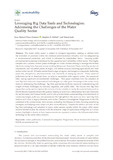JavaScript is disabled for your browser. Some features of this site may not work without it.
| dc.contributor.author | Ponce Romero, Juan Manuel | |
| dc.contributor.author | Hallett, Stephen H. | |
| dc.contributor.author | Jude, Simon | |
| dc.date.accessioned | 2017-12-14T16:18:30Z | |
| dc.date.available | 2017-12-14T16:18:30Z | |
| dc.date.issued | 2017-11-23 | |
| dc.identifier.citation | Ponce Romero JM, Hallett SH, Jude S, Leveraging big data tools and technologies: addressing the challenges of the water quality sector, Sustainability, Vol. 9, Issue 12, 2017, Article number 2160 | en_UK |
| dc.identifier.issn | 2071-1050 | |
| dc.identifier.uri | http://dx.doi.org/10.3390/su9122160 | |
| dc.identifier.uri | http://dspace.lib.cranfield.ac.uk/handle/1826/12756 | |
| dc.description.abstract | The water utility sector is subject to stringent legislation, seeking to address both the evolution of practices within the chemical/pharmaceutical industry, and the safeguarding of environmental protection, and which is informed by stakeholder views. Growing public environmental awareness is balanced by fair apportionment of liability within-sector. This highly complex and dynamic context poses challenges for water utilities seeking to manage the diverse chemicals arising from disparate sources reaching Wastewater Treatment Plants, including residential, commercial, and industrial points of origin, and diffuse sources including agricultural and hard surface water run-off. Effluents contain broad ranges of organic and inorganic compounds, herbicides, pesticides, phosphorus, pharmaceuticals, and chemicals of emerging concern. These potential pollutants can be in dissolved form, or arise in association with organic matter, the associated risks posing significant environmental challenges. This paper examines how the adoption of new Big Data tools and computational technologies can offer great advantage to the water utility sector in addressing this challenge. Big Data approaches facilitate improved understanding and insight of these challenges, by industry, regulator, and public alike. We discuss how Big Data approaches can be used to improve the outputs of tools currently in use by the water industry, such as SAGIS (Source Apportionment GIS system), helping to reveal new relationships between chemicals, the environment, and human health, and in turn provide better understanding of contaminants in wastewater (origin, pathways, and persistence). We highlight how the sector can draw upon Big Data tools to add value to legacy datasets, such as the Chemicals Investigation Programme in the UK, combined with contemporary data sources, extending the lifespan of data, focusing monitoring strategies, and helping users adapt and plan more efficiently. Despite the relative maturity of the Big Data technology and adoption in many wider sectors, uptake within the water utility sector remains limited to date. By contrast with the extensive range of applications of Big Data in in other sectors, highlight is drawn to how improvements are required to achieve the full potential of this technology in the water utility industry. | en_UK |
| dc.language.iso | en | en_UK |
| dc.publisher | MDPI | en_UK |
| dc.rights | Attribution 4.0 International | * |
| dc.rights | Attribution 4.0 International (CC BY 4.0) You are free to: Share — copy and redistribute the material in any medium or format Adapt — remix, transform, and build upon the material for any purpose, even commercially. The licensor cannot revoke these freedoms as long as you follow the license terms. Under the following terms: Attribution — You must give appropriate credit, provide a link to the license, and indicate if changes were made. You may do so in any reasonable manner, but not in any way that suggests the licensor endorses you or your use. Information: No additional restrictions — You may not apply legal terms or technological measures that legally restrict others from doing anything the license permits. | |
| dc.rights.uri | http://creativecommons.org/licenses/by/4.0/ | * |
| dc.subject | Water | en_UK |
| dc.subject | Pollutants | en_UK |
| dc.subject | Chemicals investigation programme | en_UK |
| dc.subject | Water framework directive | en_UK |
| dc.subject | SAGIS | en_UK |
| dc.subject | Environmental risk | en_UK |
| dc.title | Leveraging big data tools and technologies: Addressing the challenges of the water quality sector | en_UK |
| dc.type | Article | en_UK |
Files in this item
The following license files are associated with this item:
This item appears in the following Collection(s)
-
Staff publications (SWEE) [2822]

